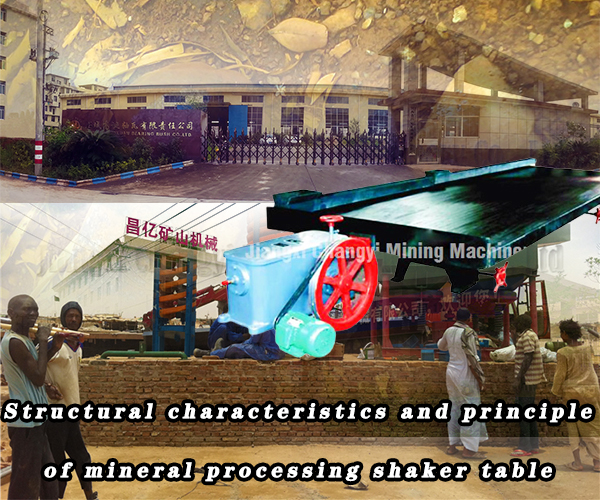Mineral processing shaker table is a kind of separation equipment for fine and fine materials with high separation accuracy, which has high enrichment when separating low-grade tungsten and tin ores. The separation efficiency is generally higher than that of other fine particle gravity separation equipment.

It is mainly used for separating tungsten, tin, tantalum, niobium, chromium, other nonferrous metals and precious metal ores, and can also be used for separating iron, manganese ores and coal. The effective separation particle size range is 3~0.019mm in metal ore separation, and the upper limit particle size can reach 10mm in coal preparation. The following introduces the structural features and principles of mineral processing rocking tables: all rocking tables are basically composed of three parts: bed surface, frame and transmission mechanism.
The shaking table surface is approximately trapezoidal or rhombic, with an inclination of 1-5d degrees in the lateral direction, and a feeding trough and a feeding trough are arranged above the inclination. Bed bars (commonly known as Laifu bars) are longitudinally arranged on the bed surface, and the height of the bed bars gradually decreases from the transmission end to the opposite side, and is pointed out along one or two oblique lines. The whole bed surface is supported by the machine frame (if it is a suspended rocking bed, the bed surface is lifted), and the machine frame is equipped with a slope adjusting device. A transmission device is arranged at one end of the longitudinal length of the bed near the ore feeding trough, which drives the bed surface to make reciprocating asymmetric motion. This kind of motion makes the front of the bed have the characteristics of quick return motion when it approaches the end, that is, the so-called differential motion.

Separation principle of mineral processing shaker table:
- The stratification of water jump and rising water flow formed when the water flows across each bed strip, and the violent shaking of the bed surface strengthens the disturbance of inclined water flow. The stratification result is that low-density fine particles are on the top, high-density coarse particles are on the bottom, while coarse-grained low-density particles and high-density fine particles are basically mixed with each other.
- The shaking table is loose due to shaking table. Under the same density condition, fine particles have greater pressure, which can pass through the gap between coarse particles and enter the lower layer of the shaking table, while high-density fine particles have greater pressure. As a result, high-density fine particles drill deeper down than low-density fine particles. In the separation process, the above two kinds of separation functions exist at the same time, and the separation and stratification play a leading role, and the rising water flow can make the low-density substances mixed into the heavy products get better separation.
- The transverse movement of ore particles on the shaking table surface is caused by the thrust of the transverse flow. The velocity distribution of the transverse flow layer in the thickness direction is greater in the upper layer than in the lower layer. Because of the obstruction of shaking table bars, the upper layer materials are greatly affected by the transverse flow, so the upper layer low-density particles have greater transverse velocity than the lower layer high-density particles.
- The longitudinal movement of ore particles on the shaking table surface and asymmetric shaking of the shaking table surface makes the ore particles move forward intermittently. Only when the inertia force of feeding ore particles on the shaking table surface is greater than the friction force between the ore particles and the shaking table surface can the ore particles start to slide relative to the shaking table surface. For low-density ore particles, the inertia force obtained in the two turning stages of advancing, retreating, retreating and advancing may be greater than the friction force between them and the shaking table surface, resulting in forward and backward sliding. However, the inertia force of forwarding movement is always greater than that of backward movement.
For high-density ore particles, only the inertia force obtained at the stage when the shaking table surface changes from forward to backward can make it slide. In addition, the lower layer of high-density ore particles clings to the shaking table surface, which can obtain a larger inertia force. The more it is located in the upper layer, the looser the shaking table, and the smaller the inertia force obtained by the ore particles. Therefore, the longitudinal velocity of high-density ore particles is greater than that of low-density ore particles.
If you are interested in shaking table, welcome to contact me:Mobile/Whatsapp/Wechat/skype: +86 15170750797 E-mail: sales8@jxchangyi.com
